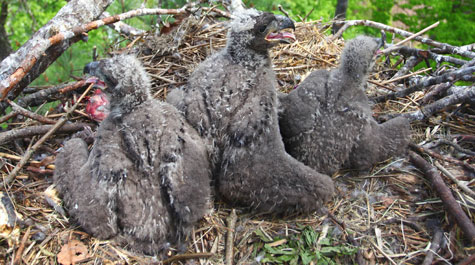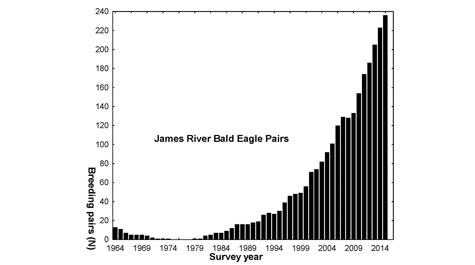Eagles continue their advance along James River

The James River continues to be one of the best barometers of bald eagle recovery within the Chesapeake Bay and likely the nation. Not only does the breeding population continue to rise to new highs year after year, but the birds also are revealing patterns that reflect their shifting ecology.
The 2015 aerial survey of the James conducted by the Center for Conservation Biology, a joint program of William & Mary and Virginia Commonwealth University, recorded 236 pairs that produced 313 young. The population increase (6 percent) over the 2014 season is slightly lower than the 30-year average and begs the question of when the growth of this population will begin to level off, said Bryan Watts, director of the Center for Conservation Biology.
Productivity (1.3 chicks/pair) is comparable to that recorded on the river over the past 10 years, with 20 percent of pairs failing to produce any young and 10 percent of pairs producing three-chick broods.
"The sheer size of the population, its momentum and the short period of recovery from the DDT era are astounding," said Watts.
In 1990, the James supported only 18 breeding pairs of eagles, and as recently as 2000, the river supported only 57 pairs. Charles City County alone now supports 51 pairs. The concentration of pairs within this historic county is part of a larger pattern of distribution along the river. Much of the colonization over the past 20 years has occurred within the upper, low-salinity reach of the watershed.

In the early 2000s, breeding density was four-fold higher along the freshwater reaches compared to the saltier reaches near the mouth of the river. Over the past 15 years, the density gap has continued to widen with the fresher areas now supporting densities more than 10 times higher than those of areas closer to the mouth of the river. This distribution pattern points to the areas along the river that are best suited to support breeding eagles.
"These same areas are where eagle management activities should be focused," said Watts.
Since the aerial survey along the James River was initiated in 1962, the results have seen the population decline to zero only to roar back in recent years to modern highs.
"Now that the population appears to be out of the woods, some may ask why the center continues to invest in surveys of this recovering population?" said Watts. "The answer is that this ecological story is not complete. Many questions remain that are significant not just to eagles but to understanding many other predator populations across the planet."
More information: Visit CCB's Eagle Nest Locator to access an interactive map of nest locations along the James River: www.ccbbirds.org/maps/#eagles
Provided by The College of William & Mary



















